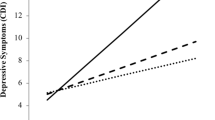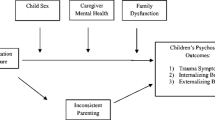Abstract
This study sought to test a serial mediation model in which depressive symptoms and hostile attributions mediate the relationship between post-traumatic stress symptoms and peer victimization in a sample of child victims of sexual abuse. Participants included 771 children aged 6 to 12 years old, consulting specialized intervention settings following disclosure of sexual abuse. Children completed questionnaires assessing their levels of post-traumatic stress symptoms, depressive symptoms and experiences of peer victimization in the school context. Vignettes were used to assess hostile attributions for instrumental and relational provocations. Results of the path analysis revealed that post-traumatic stress symptoms were associated with depressive symptoms, which were linked to greater hostile attributions for relational provocations, which were in turn associated to a greater likelihood of reporting peer victimization. Hostile attributions for instrumental provocations were not related to peer victimization.

Similar content being viewed by others
References
Barth J, Bermetz L, Heim E, Trelle S, Tonia T (2013) The current prevalence of child sexual abuse worldwide: a systematic review and meta-analysis. Int J Public Health 58(3):469–483. https://doi.org/10.1007/s00038-012-0426-1
Hébert M, Amédée LM, Blais M, Gauthier-Duchesne A (2019) Child sexual abuse among a representative sample of Quebec high school students: prevalence and association with mental health problems and health-risk behaviors. Can J Psychiatry 12:1–19. https://doi.org/10.1177/0706743719861387
Steine IM, Winje D, Skogen JC, Krystal JH, Milde AM, Bjorvatn B et al (2017) Posttraumatic symptom profiles among adult survivors of childhood sexual abuse: a longitudinal study. Child Abuse Negl 67:280–293. https://doi.org/10.1016/j.chiabu.2017.03.002
Amédée LM, Tremblay-Perreault A, Hébert M, Cyr C (2019) Child victims of sexual abuse: teachers’ evaluation of emotion regulation and social adaptation in school. Psychol Sch 56(7):1077–1088. https://doi.org/10.1002/pits.22236
Kim J, Cicchetti D (2010) Longitudinal pathways linking child maltreatment, emotion regulation, peer relations, and psychopathology. J Child Psychol Psychiatry 51(6):706–716. https://doi.org/10.1111/j.1469-7610.2009.02202.x
Auslander W, Tlapek SM, Threlfall J, Edmond T, Dunn J (2015) Mental health pathways linking childhood maltreatment to interpersonal revictimization during adolescence for girls in the child welfare system. J Interpers Violence 33(7):1169–1191. https://doi.org/10.1177/0886260515614561
Kokkinos CM, Voulgaridou I (2018) Relational victimization, callous-unemotional traits, and hostile attribution bias among preadolescents. J Sch Violence 17(1):111–122. https://doi.org/10.1080/15388200.2016.1222500
Ostrov JM, Kamper KE (2015) Future directions for research on the development of relational and physical peer victimization. J Clin Child Adolesc Psychol 44(3):1–11. https://doi.org/10.1080/15374416.2015.1012723
Aloia LS, Solomon DH (2015) Attachment, mental health, and verbal aggressiveness in personal relationships. J Aggress Maltreat Trauma 24(2):169–184. https://doi.org/10.1080/10926771.2015.1002650
Pouwels JL, Lansu TAM, Cillessen HN (2016) Participant roles of bullying in adolescence: status characteristics, social behavior, and assignment criteria. Aggress Behav 42(3):239–253. https://doi.org/10.1002/ab.21614
Rueger SY, Malecki CK, Demaray MK (2011) Stability of peer victimization in early adolescence: effects of timing and duration. J Sch Psychol 49(4):443–464. https://doi.org/10.1016/j.jsp.2011.04.005
Singham T, Viding E, Schoeler T, Arseneault L, Ronald A, Cecil CM et al (2017) Concurrent and longitudinal contribution of exposure to bullying in childhood to mental health: the role of vulnerability and resilience. JAMA Psychiatry 74(11):1112–1119. https://doi.org/10.1001/jamapsychiatry.2017.2678
Hébert M, Langevin R, Daigneault I (2016) The association between peer victimization, PTSD, and dissociation in child victims of sexual abuse. J Affect Disord 193:227–232. https://doi.org/10.1016/j.jad.2015.12.080
Tremblay-Perreault A, Hébert M (2020) Uncovering the association between child sexual abuse, peer victimization and behavior problems using child, parent and teacher reports. J Sch Violence 19(3):336–348. https://doi.org/10.1080/15388220.2019.1697276
Pittenger SL, Schreier A, Meidlinger K, Pogue JK, Theimer K, Flood MF et al (2019) Psychological distress and revictimization risk in youth victims of sexual abuse. J Interpers Violence 34(9):1930–1960. https://doi.org/10.1177/0886260516658755
Risser HJ, Hetzel-Riggin MD, Thomsen CJ, McCanne TR (2006) PTSD as a mediator of sexual revictimization: the role of reexperiencing, avoidance, and arousal symptoms. J Trauma Stress 19(5):687–698. https://doi.org/10.1002/jts.20156
Tremblay-Perreault A, Amédée LM, Hébert M (2017) Peer victimization in sexually abused children: self-blame and post-traumatic stress symptoms as possible mechanisms. Int J Child Adolesc Resil 5(1):4–19
Lahav Y, Talmon A, Ginzburg K, Spiegel D (2019) Reenacting past abuse—identification with the aggressor and sexual revictimization. J Trauma Dissociation 20(4):378–391. https://doi.org/10.1080/15299732.2019.1572046
Flory JD, Yehuda R (2015) Comorbidity between post-traumatic stress disorder and major depressive disorder: alternative explanations and treatment considerations. Dialogues Clin Neurosci 17(2):141–150
Stander VA, Thomsen CJ, Highfill-McRoy RM (2014) Etiology of depression comorbidity in combat-related PTSD: a review of the literature. Clin Psychol Rev 34(2):87–98. https://doi.org/10.1016/j.cpr.2013.12.002
Angelakis S, Nixon RD (2015) The comorbidity of PTSD and MDD: implications for clinical practice and future research. Behav Change 32(1):1–25. https://doi.org/10.1017/bec.2014.26
Chang C, Kaczkurkin AN, McLean CP, Foa EB (2018) Emotion regulation is associated with PTSD and depression among female adolescent survivors of childhood sexual abuse. Psychol Trauma 10(3):319–326. https://doi.org/10.1037/tra0000306
Reijntjes A, Kamphuis JH, Prinzie P, Telch MJ (2010) Peer victimization and internalizing problems in children: a meta-analysis of longitudinal studies. Child Abuse Negl 34(4):244–252. https://doi.org/10.1016/j.chiabu.2009.07.009
Prinstein MJ, Cheah CSL, Guyer AE (2010) Peer victimization, cue interpretation, and internalizing symptoms: preliminary concurrent and longitudinal findings for children and adolescents. J Clin Child Adolesc Psychol 34(1):11–24. https://doi.org/10.1207/s15374424jccp3401_2
Beck AT (1967) Depression. Harper and Row, New York
Dodge KA (2006) Translational science in action: hostile attributional style and the development of aggressive behavior problems. Dev Psychopathol 18(3):791–814. https://doi.org/10.1017/S0954579406060391
Schepman K, Fombonne E, Collishaw S, Taylor E (2014) Cognitive styles in depressed children with and without comorbid conduct disorder. J Adolesc 37:622–631. https://doi.org/10.1016/j.adolescence.2014.04.004
Mathieson LC, Murray-Close D, Crick NR, Woods KE, Zimmer-Gembeck M, Geiger TC et al (2011) Hostile intent attributions and relational aggression: the moderating roles of emotional sensitivity, gender and victimization. J Abnorm Child Psychol 39:977–987. https://doi.org/10.1007/s10802-011-9515-5
Dodge KA (1993) Social–cognitive mechanisms in the development of conduct disorder and depression. Annu Rev Psychol 44:559–584. https://doi.org/10.1146/annurev.ps.44.020193.003015
Classen CC, Palesh OG, Aggarwal R (2005) Sexual revictimization: a review of the empirical literature. Trauma Violence Abuse 6(2):103–129. https://doi.org/10.1177/1524838005275087
Pollak SD, Cicchetti D, Hornung K, Reed A (2000) Recognizing emotion in faces: developmental effects of child abuse and neglect. Dev Psychol 36(5):679–688. https://doi.org/10.1037/0012-1649.36.5.679
Rieder C, Cicchetti D (1989) Organizational perspective on cognitive control functioning and cognitive–affective balance in maltreated children. Dev Psychol 25:382–392. https://doi.org/10.1037/0012-1649.25.3.382
American Psychiatric Association (2013) Diagnostic and statistical manual of mental disorders, 5th edn. American Psychiatric Publishing, Arlington
Bar-Haim Y, Lamy D, Pergamin L, Bakermans-Kranenburg MJ, Van IJzendoorn MH (2007) Threat-related attentional bias in anxious and nonanxious individuals: a meta-analytic study. Psychol Bull 133(1):1–24. https://doi.org/10.1037/0033-2909.133.1.1
Pollack SD (2008) Mechanisms linking early experience and the emergence of emotions: illustrations from the study of maltreated children. Curr Dir Psychol Sci 17(6):370–375. https://doi.org/10.1111/j.1467-8721.2008.00608.x
De Bellis (2001) Developmental traumatology: the psychobiological development of maltreated children and its implications for research, treatment, and policy. Dev Psychopathol 13(3):539–564. https://doi.org/10.1017/s0954579401003078
Chemtob C, Roitblat HC, Hamada RS, Carlson JG, Twentyman CT (1988) A cognitive action theory of post-traumatic stress disorder. J Anxiety Disord 2:253–275. https://doi.org/10.1016/0887-6185(88)90006-0
Swartz JR, Graham-Bermann SA, Mogg K, Bradley BP, Monk CS (2011) Attention bias to emotional faces in young children exposed to intimate partner violence. J Child Adolesc Trauma 4(2):109–122. https://doi.org/10.1080/19361521.2011.573525
Elhers A, Clark DM (2000) A cognitive model of posttraumatic stress disorder. Behav Res Ther 38(4):319–345. https://doi.org/10.1016/S0005-7967(99)00123-0
Wiseman H, Hamilton-Giachritsis C, Hiller RM (2019) The relevance of cognitive behavioral models of post-traumatic stress following child maltreatment: a systematic review. Trauma Violence Abuse. https://doi.org/10.1177/1524838019827894
Wolfe VV (2002) The children’s impact of traumatic events scale II (CITES-II). In: Wolfe VV (ed) Unpublished assessment instrument. Child and Adolescent Centre, London Health Sciences Centre, London
Ladd GW, Kochenderfer-Ladd B (2002) Identifying victims of peer aggression from early to middle childhood: analysis of cross-informant data for concordance, estimation of relational adjustment, prevalence of victimization, and characteristics of identified victims. Psychol Assess 14(1):74–96. https://doi.org/10.1037//1040-3590.14.1.74
Ladd GW, Ettekal I, Kochenderfer-Ladd B (2017) Peer victimization trajectories from kindergarten through high school: differential pathways for children’s school engagement and achievement? J Educ Psychol 109(6):826–841. https://doi.org/10.1037/edu0000177
Kovacs M (1992) Children’s depression inventory: manual. Multi-health Systems, North Tonawanda
Crick NR (1995) Relational aggression: the role of intent attributions, feelings of distress, and provocation type. Dev Psychopathol 7(2):313–322. https://doi.org/10.1017/S0954579400006520
Wolfe VV, Gentile C, Bourdeau P (1987) History of Victimization Form. Unpublished assessment instrument. London Health Science Centre, London
Muthén LK, Muthén BO (1998–2017) Mplus user’s guide, 6th edn. Muthén and Muthén, Los Angeles
Enders CK (2001) The impact of nonnormality on full information maximum-likelihood estimation for structural equation models with missing data. Psychol Methods 6(4):352. https://doi.org/10.1037/1082-989X.6.4.352
Finkelhor D, Ormrod RK, Turner HA (2007) Re-victimization patterns in a national longitudinal sample of children and youth. Child Abuse Negl 31(5):479–502. https://doi.org/10.1016/j.chiabu.2006.03.012
Danielson CK, Macdonald A, Amstadter AB, Hanson R, de Arellano MA, Saunders BE et al (2010) Risky behaviors and depression in conjunction with—or in the absence of—lifetime history of PTSD among sexually abused adolescents. Child Maltreat 15(1):101–107. https://doi.org/10.1177/1077559509350075
LeMoult J, Gotlib IH (2018) Depression: a cognitive perspective. Clin Psychol Rev 69:51–66. https://doi.org/10.1016/j.cpr.2018.06.00
Vitaro F, Brendgen M, Barker ED (2006) Subtypes of aggressive behaviors: a developmental perspective. Int J Behav Dev 30(1):12–19. https://doi.org/10.1177/0165025406059968
Goldstein SE, Boxer P (2013) Parenting practices and the early socialisation of relational aggression among preschoolers. Early Child Dev Care 183(11):1559–1575. https://doi.org/10.1080/03004430.2012.738200
Calvete E, Orue I (2011) The impact of violence exposure on aggressive behavior through social information processing in adolescents. Am J Orthopsychiatry 81(1):38–50. https://doi.org/10.1111/j.1939-0025.2010.01070.x
Perren S, Ettekal I, Ladd G (2013) The impact of peer victimization on later maladjustment: mediating and moderating effects of hostile and self-blaming attributions. J Child Psychol Psychiatry 54(1):46–55. https://doi.org/10.1111/j.1469-7610.2012.02618.x
Turner HA, Finkelhor D, Hamby SL, Shattuck A, Ormrod RK (2011) Specifying type and location of peer victimization in a national sample of children and youth. J Youth Adolesc 40:1052–1067. https://doi.org/10.1007/s10964-011-9639-5
McElvaney R (2015) Disclosure of child sexual abuse: delays, non-disclosure and partial disclosure. What the research tells us and implications for practice. Child Abuse Rev 24(3):159–169. https://doi.org/10.1002/car.2280
Yancey CT, Hansen DJ (2010) Relationship of personal, familial, and abuse-specific factors with outcome following childhood sexual abuse. Aggress Violent Behav 15(6):410–421. https://doi.org/10.1016/j.avb.2010.07.003
Cohen JA, Mannarino AP, Deblinger E (2017) Treating trauma and traumatic grief in children and adolescents. The Guilford Press, New York
Webb C, Hayes A, Grasso D, Laurenceau JP, Deblinger E (2014) Trauma-focused cognitive behavioral therapy for youth: effectiveness in a community setting. Psychol Trauma 6(5):555–562. https://doi.org/10.1037/a0037364
Hertel PT, Mathews A (2011) Cognitive bias modification: past perspectives, current findings, and future applications. Perspect Psychol Sci 6(6):521–536. https://doi.org/10.1177/1745691611421205
Hiemstra W, De Castro BO, Thomaes S (2019) Reducing aggressive children’s hostile attributions: a cognitive bias modification procedure. Cogn Ther Res 43:387–398. https://doi.org/10.1007/s10608-018-9958-x
Lisk SC, Pile V, Haller SPW, Kumari V, Lau JYF (2018) Multisession cognitive bias modification targeting multiple biases in adolescents with elevated social anxiety. Cogn Ther Res 42:581–597. https://doi.org/10.1007/s10608-018-9912-y
Lau JYF, Sharma NP, Bennett E, Dhakal S, Vaswani A, Pandey R et al (2019) Acceptability of a brief training programme targeting attention and interpretation biases for threat in youth with a history of maltreatment. Behav Cogn Psychother 1–6:370–375. https://doi.org/10.1017/S1352465819000663
Acknowledgements
The authors would like to thank the practitioners of the different intervention settings as well as all the children and families that participated in this project.
Funding
This research was supported by a Grant from the Canadian Institutes of Health Research awarded to the first author.
Author information
Authors and Affiliations
Corresponding author
Ethics declarations
Conflict of interest
The authors declare that they have no conflict of interest.
Ethical Approval
All procedures performed in studies involving human participants were in accordance with the Ethical Standards of the Institutional and/or National Research Committee and with the 1964 Helsinki Declaration and its later amendments or comparable ethical standards.
Informed Consent
Informed consent was obtained from all individual participants included in the study.
Additional information
Publisher's Note
Springer Nature remains neutral with regard to jurisdictional claims in published maps and institutional affiliations.
Rights and permissions
About this article
Cite this article
Hébert, M., Tremblay-Perreault, A. & Myre, G. The Interplay of Depression and Hostile Attributions in the Link Between PTSD Symptoms and Peer Victimization in Child Victims of Sexual Abuse. Child Psychiatry Hum Dev 52, 291–300 (2021). https://doi.org/10.1007/s10578-020-01011-7
Published:
Issue Date:
DOI: https://doi.org/10.1007/s10578-020-01011-7




